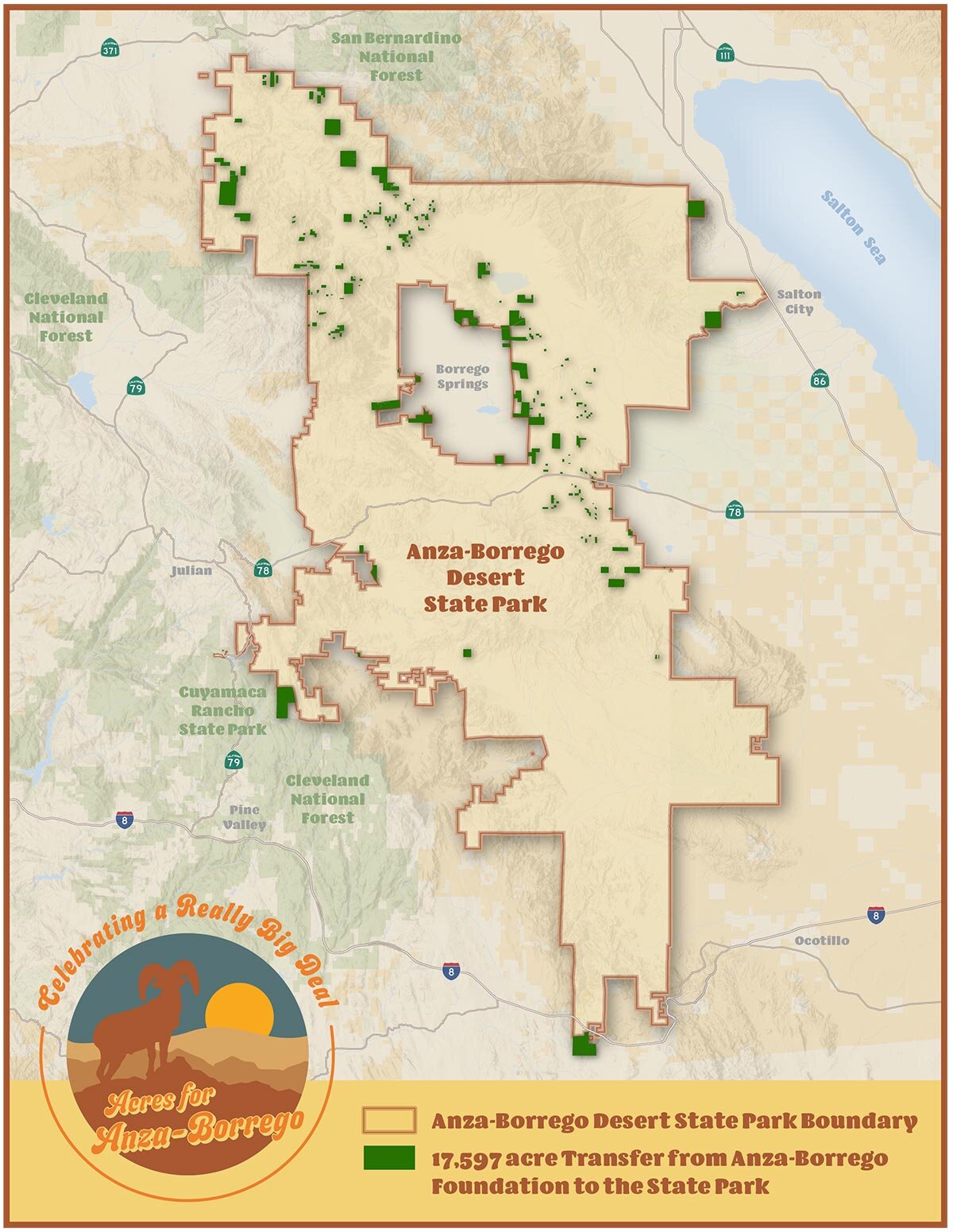
Photo Credit: Chris Jager
The Land Transfer
We dream of a day when Anza-Borrego Desert State Park becomes whole — when all lands within the Park’s established boundaries are protected forever. In the 1930s, efforts began to purchase, donate, grant, and set aside lands for ‘a great desert state park’ in Eastern San Diego County. Later, final boundaries were established for what was to eventually become the 1,000 square-mile Anza-Borrego Desert State Park that we know and love today.
Within those initial boundaries, however, there remained over 70,000 acres of private inholdings.
Photo Credit: Stefan Frutiger
In subsequent years, these in-holdings, large and small, caused serious difficulties for park managers charged with protecting the Park. On the ground, it became difficult for patrol rangers and visitors alike to determine where public property ended and private property began. Resource damage and trespass incidents were common. Some ‘in-holders’ demanded that the state park build access roads to their property. It was clear to most that to adequately preserve and protect the Park, a long-term land acquisition program was necessary to reduce the number of in-holdings and make the Park fully accessible and ‘ecologically whole’.
Accordingly, one of the most important elements of our mission here at Anza-Borrego Foundation is to secure land from willing sellers and donors for eventual transfer to Anza-Borrego Desert State Park. Since ABF’s formation in 1967, more than 55,000 acres of critical inholdings have been acquired to protect resources and improve the management and operation of the Park. These acquisitions have ranged from the Riverside County line in the North to the Mexican Border. They include properties in the iconic areas of the Park, including Borrego Palm Canyon, the Borrego Badlands, and Coyote Canyon, to name a few, and contain critical natural resources, cultural sites, and habitat for endangered species.
Overview of Land Transfer
On July 29, 2021 we celebrated the transfer of 17,597 acres of formerly private inholdings from Anza-Borrego Foundation to the state park. The lands in this transaction represent over a quarter-century of dedicated planning and work. Some parcels in the transfer were purchased by ABF as early as 1992, with the most recently acquired in 2016. The 331 parcels contained in this land transfer represent the largest and most complex transaction ever between a non-profit state park partner and California State Parks.
Watch the Celebration!
Armando Quintero, Director of California State Parks, Ray Lennox, Park Superintendent and Scott Morrison, Director of Conservation Science at The Nature Conservancy, and other notable speakers will engage and inspire you on the significance of this event and other important topics.
Stats & Highlights
Photo Credit: Anthony Arendt
17,597 acres of formerly private inholdings of land are being transferred to Anza-Borrego Desert State Park from the Anza-Borrego Foundation
The 331 separate parcels of land represent the most complex transfer of land from a non-profit state park partner to the state in the history of California State Parks
Almost 10,000 acres of the total are in designated State Wilderness Areas
This transaction “dissolves” 310 miles of private property boundaries within the State Park, simplifying park patrol and protection efforts and decreasing park management costs
The largest single parcel is 690 acres, and the smallest, a former mining claim, measures 3 feet by 402 feet
The oldest acquisition in the transfer was purchased by ABF 29 years ago, the most recent in 2016.
Much of the land in the transfer preserves bighorn sheep habitat and provides connectivity to other protected lands, such as Cuyamaca Rancho State Park and federal lands managed by the US Forest Service and the Bureau of Land Management
The transfer includes 3,500 acres in the Borrego Badlands, which contain rich paleontological resources and serve as prime flat-tailed horned lizard habitat
Over 6,000 acres are in Coyote Canyon
Hundreds of acres expand and protect the popular “Flower Fields” in the Borrego Valley, a popular springtime wildflower viewing area.
We Still Need Your Support!
Our story does not end with this historic transfer! We still have a long way to go to make the Park ecologically and geographically whole. Over 14,000 acres of critical inholdings remain scattered throughout the Park. Six crucial areas in the Park contain significant concentrations of inholdings.
These areas are all rich in natural, scenic, paleontological, and geological resources and include important cultural sites and prime habitat for endangered plants and animals.
We have not come this far without the generous help of park supporters like you. Help us finish the job. Your financial support will allow us to fulfill our long-standing dream of making the park whole. Anza-Borrego Desert State Park needs you!
All it takes is a push of the button. Please donate today!
Land Acquisition Focus Areas
Northern Coyote Canyon: 1,100 acres
Headwaters to Coyote Creek and Borrego Valley Aquifer
Mountain lion, Desert Peninsular Bighorn sheep, Quino Checkerspot Butterfly habitat
Transition from desert to chaparral higher elevation zone
Photo Credit: Judy MacLean-Fowler
Clark Dry Lake: 1,200 acres
Fairy Shrimp and Flat-tail Horned Lizard habitat
Vernally wet pools
Historical and culturally sensitive sites
Mesquite bosque, an important habitat for a surprising variety of plants and animals.
Photo Credit: Aaron Hock
Glorietta Canyon: 100 acres
Park access point
Viewshed
Potential habitat for the rare plant Hellhole Scaleseed, which has been recorded in the area, and only known within Anza-Borrego Desert State Park
Kane Springs Road: 600 acres
High diversity of cactus species in the area
Off roading threats
Cultural Sites
Desert Peninsular Bighorn Sheep, Mountain Lion habitat
Photo Credit: Carla Gilbert
Borrego Badlands: 1,800 acres
Flat-tail Horned Lizard, Desert Peninsular Bighorn Sheep
Geological significance
Unique and rare plant species such as Orcutt’s Woody-Aster and Peirson’s Pincushion that have been documented nearby.
Rare animal habitat
Paleontological significance
Old Springs Corridor: 1,000 acres
Least Bell’s Vireo, Flat-tail Horned Lizard
Fragile sand dune habitat
Area known for a spectacular spring wildflower bloom,
Off roading threat











